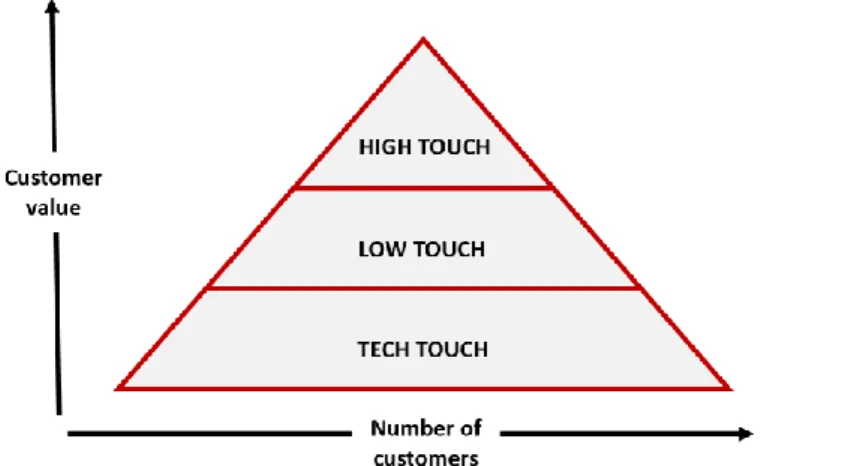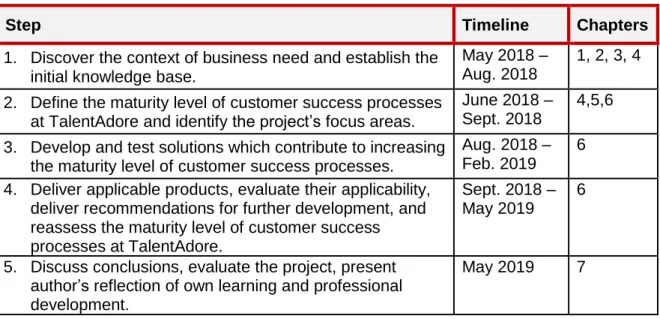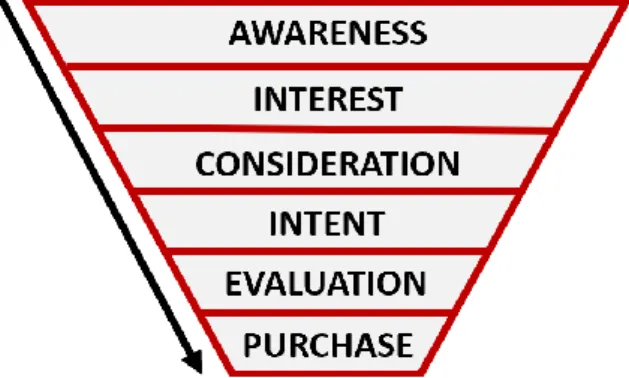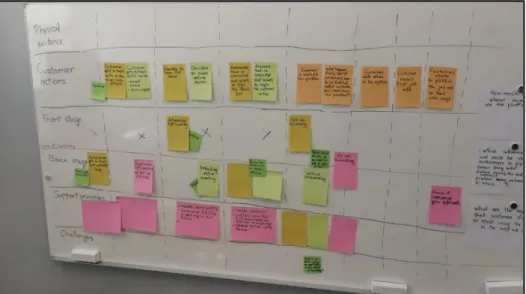Determine the maturity level of Customer Success processes at TalentAdore and identify project focus areas. Develop and test solutions that contribute to increasing the maturity level of customer success processes.
Introduction to the topic
Ccommissioning company and background
Key concepts and abbreviations
Thesis objective
Product
Thesis structure
The discussion section, chapter 7, contains a summary, conclusions and suggestions for further development, as well as the author's assessment of one's learning.
Delimitations
Carrying out certain tasks during each phase of the project's life cycle is a prerequisite for moving forward. To support the project implementation and ensure successful delivery of the final product, several methods are introduced.
Project plan
The following elements are shown in Table 1 to represent the project plan: five different project steps developed based on the Double Diamond framework, specific timelines and chapter numbers corresponding to each step. In research based on qualitative data, it is common to repeat certain processes until a satisfactory understanding is achieved.
Methods used for the creation of product
Throughout the work, desktop research is conducted to explore secondary data that has already been produced on the topic of customer success (Myers 2009, 122). It reveals a lot of information about the collective view of the company's customer success processes.
Software as a service
First, the author explains the origins of "software as a service" and how it relates to TalentAdore's business model. The concept of customer success” is explored before moving on to the practical nature of customer success and how it is accomplished at TalentAdore. Exactly as described in the previously reviewed literature, TalentAdore's business depends on its ability to maximize CLV.
What is customer success
Both research papers were commissioned by Gainsight, one of the first providers of customer success software. Following the disruption of SaaS companies and increasing interest in customer retention, a reissued guide called "The 10 Laws of Customer Success" was published by Bessemer Venture Partners.
Customer success cycle and key activities
The end of the customer success cycle means that the customer has decided to stop using it. The nature and frequency of customer success activities vary depending on the type of company.

Customer success should be a company-wide matter
At the beginning of the project, one employee had the title Customer Success Manager. Non-customer-facing roles were rarely involved in meetings with customers, although the team leader of the research and development team continuously assisted in handling customer messages in the support channel.
The importance of selling to the right customers should not be underestimated
Shared knowledge about customers was used in crucial product development discussions by involving all employees. There was hardly any documentation on the subject and even basic information about existing customers was scattered in several places.
The company should improve its ability to prevent churn continuously
The company should provide both software and expertise
Despite the fact that employee skill and knowledge will naturally accelerate as a company serves more customers, it may be beneficial to create a company-wide knowledge bank of different customer personas, best practices, and case studies.
Customer health should be managed and monitored
Resources dedicated to customers should reflect their value
The high-touch model is people-intensive and serves the most valuable customers, usually associated with high contract value. Tech-touch model is enabled by technology and delivers timely and relevant value to customers without any one-to-one touch points.

Customer feedback should be obtained to meet customer needs
While the tech-touch model is almost the only way to handle large volumes of customers in a B2C company, there are reasons why it is also widespread. Similarly, implementing the tech-touch model alone was not appropriate due to the nature of B2B operations and undefined processes. Despite the intention to standardize and automate some customer success activities, there was no basis for doing so in practice.
Due to the lack of a product owner or team leader of the customer success team, it was unclear who has the competence to make the most optimal decisions.
Time to value should be decreased to the minimum
One of the biggest challenges at the time for TalentAdore was understanding the extent to which customer feedback should be accommodated. While delivering the initial value of the product appears to be acute, it is also worth remembering that the customer success function must maximize the value derived from the product throughout the customer lifecycle. The configuration of the product and integration with TalentAdore's virtual recruitment assistant was arranged shortly after the signing of the contract.
TalentAdore's Customer Success Manager paid special attention to speeding up the process of publishing the first job ad.

Churn and retention should be measured thoroughly
Customer success function should be metrics driven
What's more, thorough data collection and measurement can provide insight into how activities from customer success managers affect customer sentiment, retention and upsells. Finally, there should be clarity about how the customer success function contributes to overall business results. TalentAdore's CEO carefully tracked business results, but they were not tied to the actions of the Customer Success Manager.
There was too limited data to evaluate how different customer success activities affect customer satisfaction and business results.
Customer experience maturity model
A consolidated assessment of CS process maturity at TalentAdore is presented before product focus areas are chosen. proactive approach is done by introducing such processes that prevent challenges before they arise. Everyone in the company understands how customer success contributes to overall business results, especially growth. Determining where the business regarding customer experience maturity can help select appropriate actions for further progress.
Customer Experience Maturity Model is used as the framework to determine if CS maturity at TalentAdore will progress during project implementation.

Initial assessment of customer success maturity at the case company
This chapter brings the project to the end of the "Define" phase and the beginning of the. First, it explains how it was decided to concentrate on specific customer success tools; then each tool is introduced. Sections dealing with tools include the following information: a map of existing reality regarding the processes that the specific tool is trying to address, expected benefits, a description of the creation process, evaluation of usability, and suggestions for further.
The maturity of customer success processes at TalentAdore is assessed again at the end of the chapter to determine whether the goal of the thesis has been achieved.
Identifying areas of focus
Dashboard for monitoring usage data
Although the dashboard was very successfully integrated into TalentAdore's operation, manual monitoring was time consuming. It was easy to explore information about one customer at the time, but it was not possible to draw quickly. After implementing the dashboard, the author recommended exploring the potential purchase of customer success software.
The dashboard could be improved, but the author felt it was not worth the effort given the amount of manual work required to interpret the data.
Visualization of the customer lifecycle
The project author created an illustration of the customer life cycle (figure 12) and used it to facilitate semi-structured customer interviews. The customer life cycle was continually expanded as the author learned that some of the stages did not resonate with customers and could not be easily understood. It was intended to describe what support activities are required of TalentAdore teams at each stage of the customer lifecycle.
To summarize, customer lifecycle was supposed to serve as the tool to understand what should happen during each stage of the lifecycle.

Onboarding playbook
It was very challenging to observe the onboarding process because it happened in the language that the author does not speak. This feature allowed designing customer journey templates that can be applied to the customer at different life cycle stages. Even when the type of activity indicated that action was required from the customer side, the responsible person from the customer success team.
Since the company provided people with intensive support during the onboarding period and lacked the resources to maintain the same level of engagement throughout the customer's lifetime, this was very important.

Customer health card
Based on the data, the client has not yet performed one full job and used the main functions, so a yellow health indicator is used. All engagement boxes are green because the customer has been in contact with TalentAdore recently and more than half of the company's users have opened newsletters with information about what's new. The creation process itself was important as it raised the awareness of the customer success team and provided an overview of the entire customer base.
In January 2019, the author was asked to create one more health card and consolidate all the findings into an engaging presentation that was shown to the company's board.
Repeated assessment of customer success maturity at the case company
Each employee, including the project author, had clearly defined responsibilities that contributed to the customer success team's goals (Exhibit 12). The head of CS coordinated the work of the customer success team and the research and development team. Input from customer interactions and new sales engagements was reviewed weekly during the internal customer success team meeting.
The purchase of Planhat's customer success software was expected to help build the capacity and scalability of the customer success function.

Summary and conclusion
Regarding the literature review, the collection of secondary data was necessary for the author's initial knowledge of the concept of customer success. Given that the author had no prior expertise in customer success and the client's operations, an unstructured observation approach was adopted. The implementation of the project helped raise awareness that customer success is a business-wide concern and initiated transformation.
In addition to the project implementation, the author was asked to generate constant improvements (many of which were not described in this work) and contribute to the Customer Success Team's responsibilities.

Evaluation of one’s learning
Company wide awareness of customer success was growing by showing how to use customer success tools. Over the following months, our team grew and we purchased customer success software that enabled further development of several tools. Iteration rounds of delivered customer success tools were completed around the end of February, giving several months to observe and evaluate their applicability.
I followed the double diamond framework, identified the maturity of the customer success processes at the commissioning company and provided the tools for customer success, but it was not easy to reflect all of this in writing.
Proposed key performance indicators for the dashboard
Email presenting the business need for developing the dashboard
Given this background, in the future it would be good to consider implementing a system similar to https://www.planhat.com/, to activate internal alerts and automatically distribute the appropriate content, but for now we have to to look for a solution that can help us create core customer success processes with existing resources. I personally aim to ensure that the new KPIs are used, analyzed and reviewed on a weekly basis (customers in the adoption phase) and on a monthly basis (customers already on board) by myself and the Customer Success team if they are to we implement them. Additionally, it would allow me to observe product adoption (useful for standardizing onboarding), because onboarding is not just an appointment, but the process from the first point of contact to the successful use of VRA ours to be closely monitored.
The customer success team is already using the information available in the admin view and they reaffirmed that the information listed would be helpful.
Email invitation to the meeting that was sent to customers
Presentation attached to the meeting invitation
Evolved visualization of the customer lifecycle
Hiring managers guide
What’s new page
Post-sales handover form
Onboarding requirements checklist
Onboarding follow-up mterial 1
Onboarding follow-up material 2
Her job is to work closely with customers to achieve results that lead to successful product adoption, renewal, expansion and advocacy with all relevant stakeholders, especially customers. A critical part of the job is team collaboration with the goal of advancing product development and making effective use of company resources. 1-2 blog posts: “How to get the most out of the Talent Community” and “How to get the most value out of VRA”.
Author’s personal development plan
Author’s traineeship review





